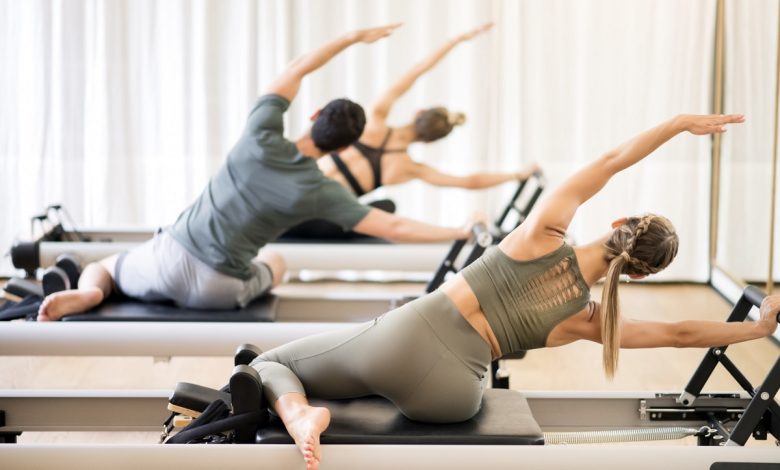Pilates And Yoga: What Are The Differences Between Pilates And Yoga?

Pilates And Yoga: One of the key benefits of Pilates is how it shapes your body. It sculpts and strengthens muscles without adding bulk, leading to a leaner physique.
If you’re looking to improve flexibility and perform more stretches—whether for daily life or enhancing the range of motion in another sport—you might consider trying yoga or Pilates.
Both offer numerous health benefits, from body awareness and stress reduction to increased flexibility, strength, control, and endurance. However, fundamentally, these two disciplines are quite different.
Pilates And Yoga, Yoga originates from ancient India and offers a holistic approach to integrating mind, body, breath, and spirit for mental and physical rejuvenation. Modern yoga places significant emphasis on asanas or yoga poses, but physical practice is just one of the eight limbs of yoga. Other limbs include ethical guidelines, self-discipline, breath control, sensory transcendence, concentration, meditation, and a state of bliss that transcends the self.
Pilates, named after its creator Joseph Pilates, a German anatomist, involves a series of highly controlled movements. Initially called “Contrology” before adopting its inventor’s name, Pilates requires the mind to precisely control the bones and muscles in each movement. Unlike yoga, it focuses less on overall spirituality and more on the physical mind-body connection. A key difference is that all Pilates movements originate from the core, making it an excellent choice for individuals recovering from back injuries or building strength post-pregnancy.
Pilates And Yoga, If you’re unsure which would benefit you more, we’ll explain how yoga and Pilates work and how each can help you feel more physically and mentally fit.
Pilates And Yoga
What Is Pilates?
Pilates And Yoga, Pilates is a form of exercise that focuses on balance, mobility, and overall body strength through proper breathing and core engagement. This low-impact aerobic workout effectively strengthens muscles while improving posture and core strength.
For most people, Pilates is excellent for improving balance, enhancing full-body strength, boosting mind-body connection, and correcting postural imbalances. It also teaches proper functioning of the core and pelvic floor. Pilates is ideal for pre- and post-natal women, athletes looking to enhance performance, and aging adults needing to improve balance and posture.

Pilates And Yoga, Pilates classes typically last between 45 minutes to an hour, often shorter than yoga classes. In these classes, you’ll find many repeated movements, which is great for beginners who want to track their progress consistently and feel the exercises becoming easier over time.
Key Pilates movements include “The Hundred,” a breathing exercise focused on core strength and balance, “Roll-Up,” a slow and precise move that stretches the spine and back while strengthening the abdomen, and the deceptively simple “Leg Circles,” which challenge and strengthen the hips and core stabilizers.
What Is The Difference Between Mat Pilates And Reformer Pilates?
Pilates And Yoga, Both Mat Pilates and Reformer Pilates are excellent for improving strength, coordination, balance, flexibility, and mobility. Reformer Pilates is performed on a machine that uses straps, springs, and a platform to assist and increase the intensity and resistance of exercises. If you’re new to Pilates, using the reformer can make stretches easier by guiding your movements.
However, it’s also great for advanced practitioners as it provides a way to push their limits. Reformer classes tend to be more expensive and aren’t as feasible to do at home.
Pilates And Yoga, Mat Pilates can theoretically be done anywhere you have space for a mat, and there are numerous free workouts on YouTube to follow. Using your body weight is sufficient to challenge your muscles, and you can see significant improvements in muscle strength and flexibility without any cost. It may be slightly harder for beginners initially, but regular practice will make it easier.
What Are The Benefits Of Pilates?
Pilates And Yoga, One of the key benefits of Pilates is how it shapes your body. It sculpts and strengthens muscles without adding bulk, leading to a leaner physique.
As we age, our bodies often become stiffer. Pilates exercises enhance joint and muscle flexibility, allowing for a broader range of motion and easier movement in daily activities. Pilates can also help prevent injuries by promoting balanced muscle development throughout the body and strengthening the core muscles.
Pilates And Yoga, Of course, the benefits aren’t purely physical. Focusing on breathing during exercises helps manage stress and leaves you feeling energized. Regular Pilates practice can even improve sleep and cognitive function.
What is Yoga?
Pilates And Yoga, Yoga is an ancient practice originating from India that goes beyond physical exercise. It combines physical postures (asanas), breathing techniques (pranayama), and meditation to promote mental and spiritual health.
The physical postures improve flexibility, strength, and balance. Breathing exercises calm the mind and enhance lung capacity. Meditation fosters focus and inner peace.
There are many different styles of yoga, ranging from gentle and restorative to powerful and athletic. Whether you’re looking to reduce stress, improve fitness, or deepen your connection with yourself, there’s likely a yoga practice suited for you.
Pilates And Yoga, Yoga poses are called asanas, and there are hundreds of them. Many classes incorporate foundational poses you’ll encounter repeatedly. For example, Downward-Facing Dog is a common pose for stretching the lower body and back. Backbends like Cobra pose open the chest and increase flexibility. Standing poses like Tree Pose or Warrior I and II build strength and balance.
What Are The Benefits Of Yoga?
Pilates And Yoga, Yoga offers a wide range of benefits for both the mind and body. Asanas improve flexibility, build strength, and enhance balance. This can lead to better posture, pain relief (especially back pain), and even improved athletic performance.
Yoga also includes breathing exercises that help manage stress and anxiety. Focusing on the breath calms the nervous system and fosters relaxation. Additionally, yoga often involves meditation, which nurtures mindfulness and inner peace.
If you struggle with anxiety or low self-esteem, yoga can help by calming the mind. Meditation has been shown to increase levels of a brain chemical called gamma-aminobutyric acid (GABA), which is linked to improved mood and reduced anxiety.
Verdict: Pilates Vs. Yoga
Pilates And Yoga, Pilates is excellent for core strengthening, improving posture, and sculpting long, lean muscles. A 45-minute class or two sessions a week is enough to make a significant difference in your physical and mental well-being.
Strengthening the core through Pilates can greatly alleviate back pain. Yoga requires a bit more time commitment but focuses more on mental health and inner peace. These two disciplines aren’t necessarily mutually exclusive. Many people practice both because the core strength gained in Pilates can aid in deeper stretches in yoga, and the mental wellness fostered by yoga can enhance the focus needed for body control in Pilates.
Also Read:
The 6 Best Yoga Poses For Spring And Beginners
The 6 Best Face Yoga Exercises You Can Do It At Home
Health Benefits Of Yoga: The 8 Best Benefits Of Yoga For Health




